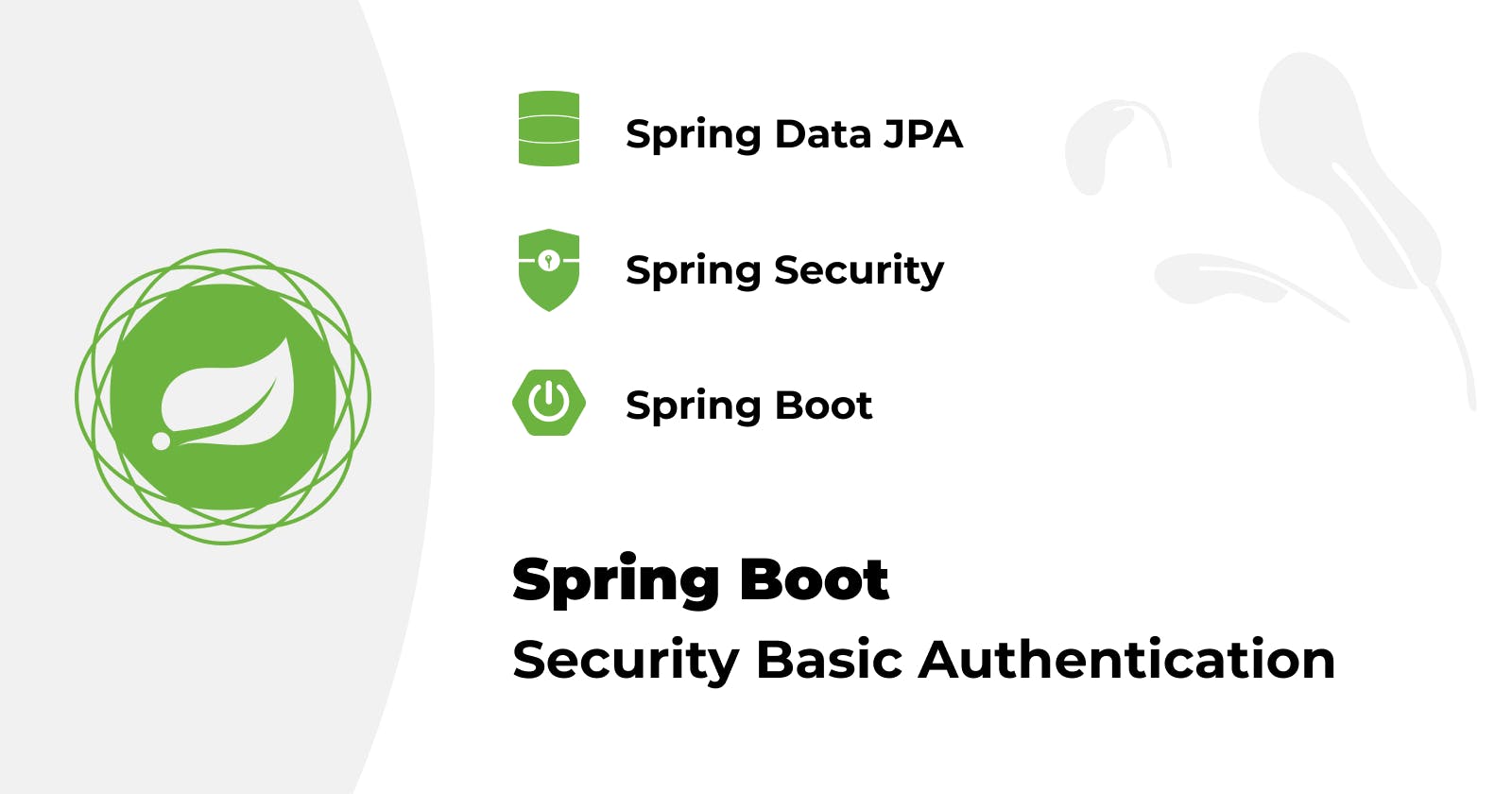This guide walks you through the process of building a Spring boot 2 application that uses Spring Security and Spring Data JPA. Applying the new way to configure Spring Security without the WebSecurityConfigurerAdapter
What You Will build
You will build a Spring Boot application with Spring Security basic authentication and Spring Data Jpa for managing the users.
What You Need
- A favorite text editor or IDE
- JDK 1.8 or later
- Gradle 4+ or Maven 3.2+
Setup Project With Spring Initializr
Navigate to start.spring.io
define the project name example:
spring-boot-security-basic-auth- Choose Project Maven and the language Java.
- Choose Your Java version ex: 17
Click add dependencies and select:
- Spring Web
- Spring Security
- Spring Data JPA
- H2 Database
- Lombok
Click Generate.
Unzip the Downloaded Zip and open the Project using your favorite text editor or IDE
Start the implementation
Define the User Entity, implement the UserDetails interface and override the implemented methods
@Entity(name = "users")
@Getter
@Setter
public class User implements UserDetails {
@Id
@GeneratedValue(strategy = GenerationType.IDENTITY)
private Long id;
private String firstName;
private String lastName;
@Column(unique = true)
private String username;
private String password;
@Override
public Collection<? extends GrantedAuthority> getAuthorities() {
return Collections.emptyList();
}
@Override
public String getPassword() {
return this.password;
}
@Override
public String getUsername() {
return this.username;
}
@Override
public boolean isAccountNonExpired() {
return true;
}
@Override
public boolean isAccountNonLocked() {
return true;
}
@Override
public boolean isCredentialsNonExpired() {
return true;
}
@Override
public boolean isEnabled() {
return true;
}
}
Define the User Repository and the query method findOneByUsername
Lean more about query methods here
@Repository
public interface UserRepository extends JpaRepository<User, Long> {
Optional<User> findOneByUsername(String username);
}
Define the User Details Service implementation that will manage user authentication.
public class CustomUserDetailsService implements UserDetailsService {
private UserRepository userRepository;
public CustomUserDetailsService(UserRepository userRepository) {
this.userRepository = userRepository;
}
@Override
public UserDetails loadUserByUsername(String username) throws UsernameNotFoundException {
return userRepository.findOneByUsername(username).orElseThrow(() -> {
throw new UsernameNotFoundException(username);
});
}
}
Define the Spring Security Configuration, You will notice that we didn't extend the WebSecurityConfigurerAdapter we just define beans at this level
@Configuration
public class SecurityConfiguration {
/**
* Define the password encoder.
*
* @return {@link BCryptPasswordEncoder}
*/
@Bean
public PasswordEncoder passwordEncoder() {
return new BCryptPasswordEncoder();
}
/**
* Define the user service to retrieve and authenticate the user.
*
* @param userRepository
* @return {@link UserDetails}
*/
@Bean
CustomUserDetailsService customUserDetailsService(UserRepository userRepository) {
return new CustomUserDetailsService(userRepository);
}
/**
* Define the filer chain.
*
* @param http
* @return {@link SecurityFilterChain}
* @throws Exception
*/
@Bean
public SecurityFilterChain filterChain(HttpSecurity http) throws Exception {
http.authorizeHttpRequests(
(authz) -> authz.antMatchers("/secured").authenticated().anyRequest().permitAll())
.httpBasic();
return http.build();
}
}
Define the Rest Controller with some routes
@RestController
public class AppResource {
@GetMapping("/**")
public String any() {
return "Hello World";
}
@GetMapping("/secured")
public String secured(Authentication auth) {
User user = ((User) auth.getPrincipal());
return "Hello " + user.getFirstName() + " " + user.getLastName();
}
}
Create data.sql under the resources folder to populate our table
INSERT INTO USERS (FIRST_NAME, LAST_NAME, USERNAME, PASSWORD) VALUES
-- password is '123'
('john', 'doe', 'admin', '$2a$12$vl2OJQMtIZutojuJVhaRXuLmkyFV1QgE24HqFPWoYTmPOXa6wOUbi');
When running the application, by default the data.sql will be executed before the entity creation into the database, to prevent that add the following property under the application.properties
spring.jpa.defer-datasource-initialization=true
Testing
Write some test cases to check that the uri /secured is working as expected
- Test 1 : check with correct credentials
- Test 2 : check with wrong credentials
@ExtendWith(SpringExtension.class)
@SpringBootTest(webEnvironment = WebEnvironment.RANDOM_PORT)
public class SpringBootSecurityBasicAuthApplicationTests {
private final String USERNAME = "admin";
private final String PASSWORD = "123";
private final String WRONG_PASSWORD = "bvfsdg";
@Autowired
TestRestTemplate template;
@Test
public void accessPrivateResourceSuccess() throws Exception {
ResponseEntity<String> response = template.withBasicAuth(USERNAME, PASSWORD)
.getForEntity("/secured", String.class);
assertEquals(HttpStatus.OK, response.getStatusCode());
}
@Test
public void accessPrivateResourceFaildGivingWrongPassword() throws Exception {
ResponseEntity<String> response = template.withBasicAuth(USERNAME, WRONG_PASSWORD)
.getForEntity("/secured", String.class);
assertEquals(HttpStatus.UNAUTHORIZED, response.getStatusCode());
}
}
Run The Application
Run the Java application as a SpringBootApplication with your IDE or use the following command line
./mvnw spring-boot:run
Now, you can open the URL below on your browser, default port is 8080 you can set it under the application.properties
http://localhost:8080/
When you access the secured URI /secured, a prompt shows up pass in the username & password
- username : admin
- password : 123
http://localhost:8080/secured
Summary
Congratulations 🎉 ! You've created a Spring Security application with basic authentication using Spring Boot 2 & JPA
Github
The tutorial can be found here on Github 👋

